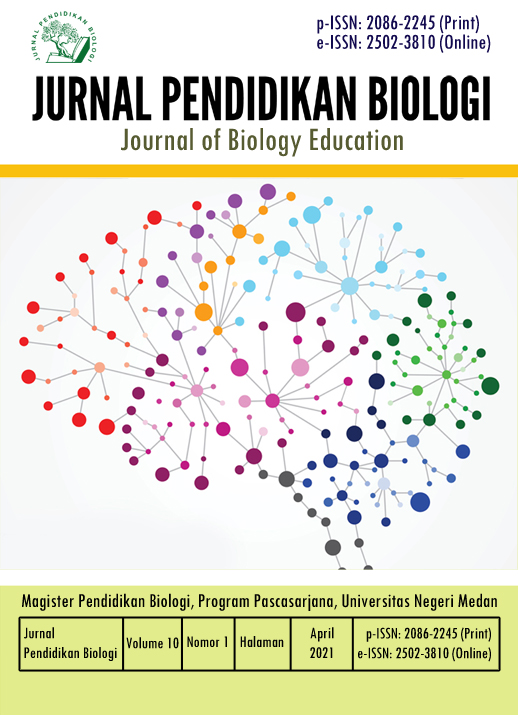Use of Peer Assessment and Self-Assessment in Class Discussions to Assess Concept Understanding Ability of Prospective Biology Educators
DOI:
https://doi.org/10.24114/jpb.v10i1.21750Keywords:
Peer Assessment, Self Assessment, Class Discussion, Concept Understanding AbilityAbstract
The ability of understanding important concepts held by educators and learners. This ability is fundamental in achieving one of the outcomes of learning. Their understanding of the concept of ownership is the ability of a person can use in solving a problem that is related to the concept in everyday life. This descriptive study aims to obtain a description of the conceptual understanding of prospective biology educator students through the use of peer and self-assessment in class discussions. The research subjects were 26 prospective Biology educator students of the 2019/2020 academic year who contracted the human body anatomy physiology course. The instruments used consisted of peer and self assessment sheets, lecturer observation sheets and conceptual understanding questions. Data analysis was carried out quantitatively and qualitatively. The results showed that the average peer assessment score was greater than the self assessment, where the peer assessment was in the moderate category (49%) and the self assessmet was in the poor category (34%). There were only 10 students (38.46%) who were in conformity between peer and self assessment with adequate and insufficient categories. The discrepancy was found in 16 students (61.54%) with the category enough, less and very less. The ability to understand the concept of students on each indicator shows different percentage mean. The highest percentage of concept understanding ability indicators is found in the indicators of explaining the concept with its own sentence structure about something that is read or heard clearly / concretely by 64% (Good), while the lowest percentage of indicators of concept comprehension ability is found in the indicators able to connect symbolic forms (pictures, tables, concept maps, diagrams, graphs, mathematical equations, and other formulas) in concepts with other concepts of 51% (Enough).References
Adhani, A., & Rupa, D. (2020). Analisis Pemahaman Konsep Mahasiswa Pendidikan Biologi Pada Matakuliah Fisiologi Tumbuhan. Quantum: Jurnal Inovasi Pendidikan Sains, 11(1). https://doi.org/10.20527/quantum.v11i1.8035
Afifah, N. (2017). Pembelajaran dengan metode diskusi kelas. Tarbawiyah: Jurnal Ilmiah Pendidikan, 11(01), 53-65.
Alias, M., Masek, A., & Salleh, H. H. M. (2015). Self, Peer and Teacher Assessments in Problem Based Learning: Are They in Agreements? Procedia - Social and Behavioral Sciences, 204. https://doi.org/10.1016/j.sbspro.2015.08.157
Anderson, K., PW, A., KA, C., Mayer, R., PR, P., Raths, J., & MC, W. (2001). A Taxonomy for Learning, Teaching, and Assessing: A Revision of Bloom™s Taxonomy of Educational Objectives.
Arends, R. I. (2015). Learning to Teach (Tenth Edition). In McGraw-Hill Education: Vol. Tenth Edit.
Arikunto, S. (2010). Dasar-dasar Evaluasi Pendidikan (Edisi Revisi). Jakarta: Bumi Aksara.
Black, P., Harrison, C., Lee, C., Marshall, B., & Wiliam, D. (2004). Working inside the black box: Assessment for learning in the classroom. Phi Delta Kappan, 86(1), 8“21. https://doi.org/10.1177/003172170408600105
Firman, H.(2000). Penilaian Hasil Belajar dalam Pengajaran Kimia. Bandung: Jurusan Penididikan Kimia FPMIPA UPI.
Hairida, H. (2018). Penilaian Sikap Siswa Dalam Pembelajaran Kimia Melalui Teknik Self Assessment dan Peer Assessment. Jurnal Pendidikan Matematika Dan IPA, 9(2). https://doi.org/10.26418/jpmipa.v9i2.25832
Hamdani, D., Eva, K., & Indra, S. (2012). Pengaruh Model Pembelajaran Generatif Dengan Menggunakan Alat Peraga Terhadap Pemahaman Konsep Cahaya Kelas Viii Di Smp Negeri 7 Kota Bengkulu. Exacta, 10(1).
Juhanda, A. (2017). Optimalisasi Diskusi Kelas Melalui Peer Assessment dan Self Assessment Untuk Menilai Kemampuan Komunikasi Lisan Mahasiswa Calon Guru Biologi. Jurnal Pendidikan Matematika Dan IPA, 8(2). https://doi.org/10.26418/jpmipa.v8i2.21170
Karimah, H. N., Windyariani, S., & Aliyah, H. (2020). Penggunaan Assesment for Learning Berbasis Comment Only Marking Terhadap Hasil Belajar Kognitif Siswa. BIODIK, 6(3), 255-265. https://doi.org/10.22437/bio.v6i3.9578
Meltzer, D.E. (2002). Normalized Learning Gain: A Key Measure of Student Learning, Addendum to Meltzer (2002). [Online]. Tersedia: http://www.physicseducation.net/docs/Addendum_on_normalized_gain.pdf (15 April 2021)
Purwanto, N. (2009). Prinsip-Prinsip dan Teknik Evaluasi Pengajaran. Bandung: Remaja Rosdakarya.
Purwanto. (2008). Evaluasi Hasil Belajar. Yogyakarta: Pustaka Pelajar.
Siswaningsih, W., Dwiyanti, G., & Gumilar, C. (2013). Penerapan Peer Assessment dan Self Assessment Pada Tes Formatif Hidrokarbon Untuk Feedback Siswa SMA KELAS X. Jurnal Pengajaran Matematika Dan Ilmu Pengetahuan Alam, 18(1). https://doi.org/10.18269/jpmipa.v18i1.263
Shofiyah, H. & Wasis. (2013). Penerapan Self Assessment pada Kegiatan Praktikum untuk Meningkatkan Hasil Belajar Siswa Kelas X SMAN 1 Sidayu. Jurnal Inovasi Pendidikan Fisika. 2(3), 139-142.
Subiyanto. (1988). Evaluasi Pendidikan dan Pengetahuan Alam. DEKDIKBUD.
Suyono & Hariyanto. (2012). Belajar dan Pembelajaran. Bandung: PT. Rosdakarya Remaja.
Tendrita, M. (2017). Peningkatan Aktivitas Belajar dan Pemahaman Konsep Biologi Dengan Strategi Survey, Question, Read, Recite, Review (SQ3R) Pada Siswa Kelas XI IPA SMA Negeri 5 Kendari. Jurnal VARIDIKA, 28(2). https://doi.org/10.23917/varidika.v28i2.2867
Wijayanti, A. (2017). Efektivitas Self Assessment dan Peer Assessment Dalam Pembentukan Karakter Siswa. Realita. 15(2), 1-14. https://doi.org/10.30762/realita.v15i2.482
Yanti, W. (2019). Penggunaan Model Pembelajaran Langsung (Direct Instruction) Untuk Meningkatkan Hasil Belajar Biologi Siswa Kelas X IPA 1 SMA Negeri 15 Kota Takengon Tahun Pelajaran 2018-2019. Jurnal Biotik. 7(2), 115-120. http://dx.doi.org/10.22373/biotik.v7i2.5652
Downloads
Published
Issue
Section
License
Copyright (c) 2021 Jurnal Pendidikan Biologi

This work is licensed under a Creative Commons Attribution 4.0 International License.
Copyright
Penyerahan naskah menyiratkan bahwa karya yang diserahkan belum pernah diterbitkan sebelumnya (kecuali sebagai bagian dari tesis, laporan, atau abstrak). Naskah tidak dipertimbangkan untuk publikasi di tempat lain. Penerbitannya telah disetujui oleh semua penulis bersama. Jika dan kapan naskah diterima untuk publikasi, penulis masih memegang hak cipta dan mempertahankan hak penerbitan tanpa batasan. Penulis atau orang lain diperbolehkan untuk melipatgandakan artikel selama tidak untuk tujuan komersial. Untuk penemuan baru, penulis disarankan untuk mengelola patennya sebelum diterbitkan.
Open Access
Jurnal ini berkomitmen untuk membuka akses bebas yang tidak membebankan biaya kepada pembacanya atau lembaga mereka. Pembaca berhak membaca, mengunduh, menyalin, mendistribusikan, mencetak, mencari, atau menautkan ke teks lengkap artikel, selama tidak untuk tujuan komersial. Jenis lisensi adalah CC-BY-4.0.
Disclaimer
Tidak ada tanggung jawab yang dikenakan kepada Penerbit atau oleh editor untuk kesalahan dan/atau kerusakan pada naskah sebagai akibat dari pernyataan pencemaran nama baik atau dugaan pencemaran nama baik, pelanggaran hak kekayaan intelektual atau privasi, atau kewajiban produk, baik akibat kelalaian atau sebaliknya, atau dari penggunaan atau operasi ide, instruksi, prosedur, produk atau metode apa pun yang terkandung dalam materi di dalamnya.

